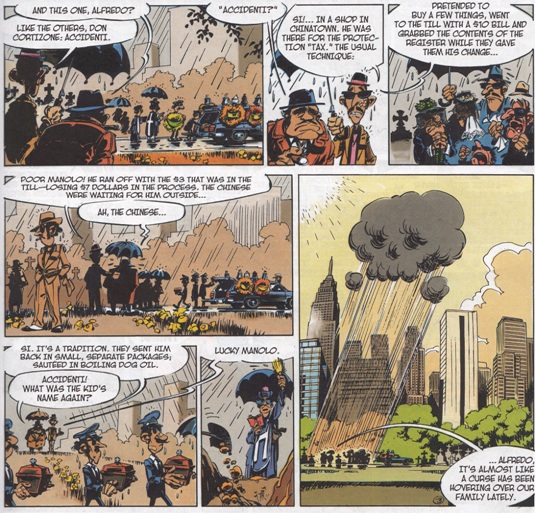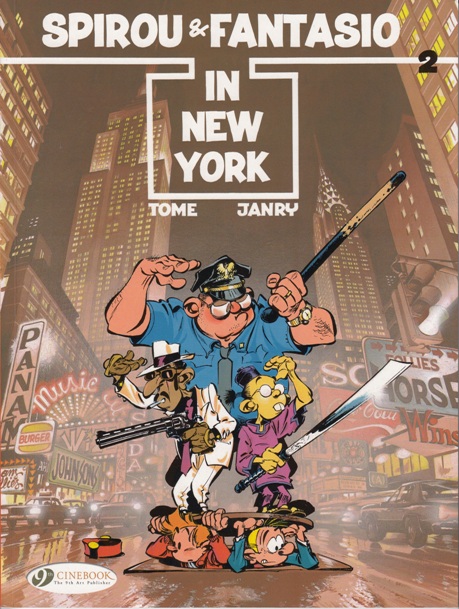Spirou and Fantasio in New York
Reviewed by JT Lindroos 11-May-11
Spirou and Fantasio is one of the great comic creations from the Franco-Belgian lineup, much loved since the intrepid titular team of newspaper reporters first appeared in 1938. This album, 39th out of 60 or so, is peculiarly the second one translated and published by Cinebook, and far as I can tell, only the third Spirou book published in English.
Spirou and Fantasio is one of the great comic creations from the Franco-Belgian lineup, much loved since the intrepid titular team of newspaper reporters first appeared in 1938. This album, 39th out of 60 or so, is peculiarly the second one translated and published by Cinebook, and far as I can tell, only the third Spirou book published in English (Fantasy Flight published the classic Andre Franquin tale Z is For Zorglub in the 1990s with a translation by Kim Thompson). Written and illustrated by the reboot team of Tome and Janry in the late 80’s, Spirou and Fantasio in New York is hardly the cream of the crop by most readers’ standards, but it is a fast-paced and amusing confection littered with an endless stream of silly slapstick and cute visual gags.
The story is as follows: Don Vito Cortizone runs the Italian mafia in New York City. A spell of terrible bad luck has been cast on his operation by the Chinese master criminal “Mandarin”. After a terrible streak of mishaps and accidents, they find the luckiest people alive to counter all the bad mojo. Enter Spirou and Fantasio. Much chaos ensues.
 What’s most interesting about this book is appearances. It’s littered with racial stereotypes of the most offensive kind, from yellow peril Chinese with enormous buckteeth and droopy Fu Manchu mustaches, to greasy Italian pizza-loving mafiosos to irate big-lipped black cab drivers and more. This is often true of many of the bigfoot style artists in the European tradition. What is odd — and maybe I’m just not sensitive enough to the issue — is that they get away with it. In this book everybody is a caricature, exaggerated and idiosyncratic, and such indiscriminate tomfoolery results not in anything offensive, but amounts to an off-kilter Looney Tunes atmosphere. The gags fly at such a pace that you’ll do well re-reading the book and scanning each picture for off-the-cuff eyeball kicks. The drawings are fluid, active and loose, and while the book doesn’t equal the mad precision of Franquin’s work in the prime of Spirou, they still do the job of providing chuckles and high voltage child friendly carnage.
What’s most interesting about this book is appearances. It’s littered with racial stereotypes of the most offensive kind, from yellow peril Chinese with enormous buckteeth and droopy Fu Manchu mustaches, to greasy Italian pizza-loving mafiosos to irate big-lipped black cab drivers and more. This is often true of many of the bigfoot style artists in the European tradition. What is odd — and maybe I’m just not sensitive enough to the issue — is that they get away with it. In this book everybody is a caricature, exaggerated and idiosyncratic, and such indiscriminate tomfoolery results not in anything offensive, but amounts to an off-kilter Looney Tunes atmosphere. The gags fly at such a pace that you’ll do well re-reading the book and scanning each picture for off-the-cuff eyeball kicks. The drawings are fluid, active and loose, and while the book doesn’t equal the mad precision of Franquin’s work in the prime of Spirou, they still do the job of providing chuckles and high voltage child friendly carnage.
In the end Spirou and Fantasio in New York doesn’t amount to a whole lot, but that doesn’t negate the fact that it is energetic, entertaining, well-translated and affordable. And it might eventually lead to the publication of Franquin’s Spirou books, which alone makes it a worthwhile buy.
Tags: Cinebook, Janry, Spirou, Spirou and Fantasio, Tome